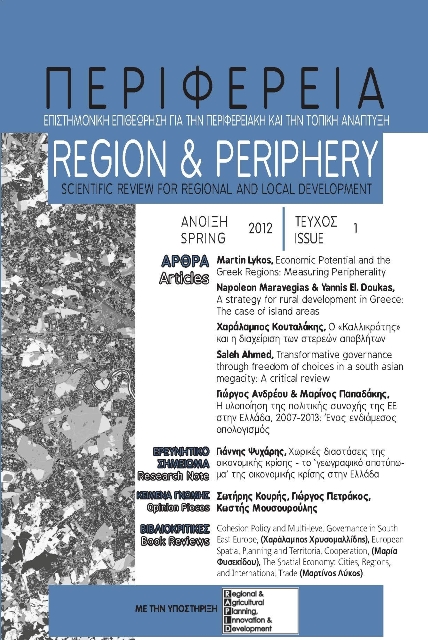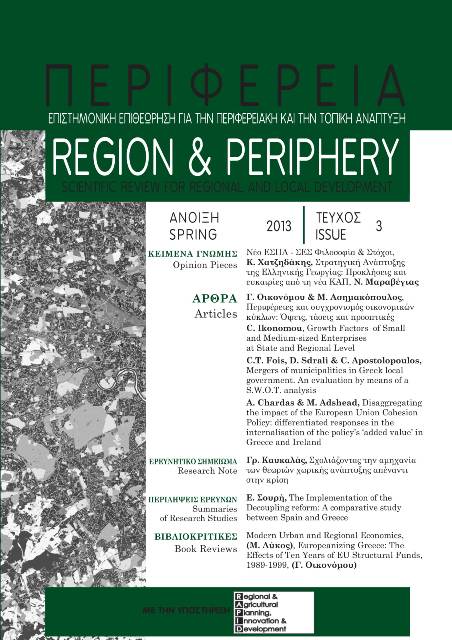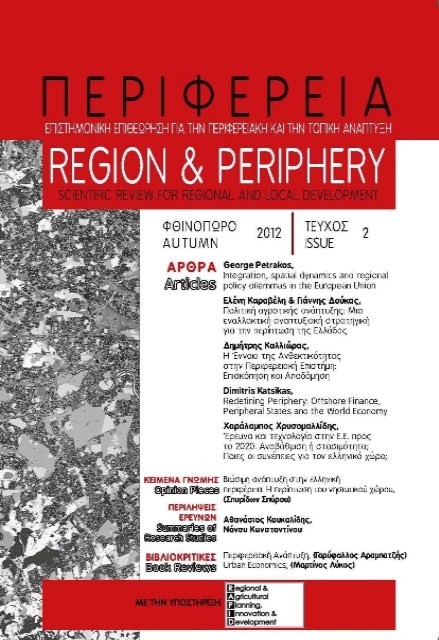Οικονομική Δυναμική και Ελληνικές Περιφέρειες: Μέτρηση της Περιφερειακότητας

Περίληψη
Η παρούσα μελέτη εξετάζει τη χωρική ανάπτυξη στην Ελλάδα σε συνάρτηση με την οικονομική δυναμική των περιφερειών της. Για αυτό το σκοπό χρησιμοποιούνται στατιστικά εργαλεία όπως η οικονομική δυναμική / περιφερειακότητα των ελληνικών περιφερειών επιπέδου NUTS 3. Το οικονομικό κέντρο της Αττικής / καθορίζει την οικονομική δυναμική στο υπόλοιπο της χώρας, όπως δείχνει η ανάλυση. Οι χαμηλότεροι δείκτες περιφερειακότητας εμφανίζονται στην Αττική και στους όμορούς της νομούς ενώ οι υψηλότεροι σε νομούς που συνδυάζουν ιδιαίτερα απόκεντρη θέση και χαμηλή εντόπια οικονομική δραστηριότητα.
Λεπτομέρειες άρθρου
- Πώς να δημιουργήσετε Αναφορές
-
Λύκος Μ. (2012). Οικονομική Δυναμική και Ελληνικές Περιφέρειες: Μέτρηση της Περιφερειακότητας. Περιφέρεια | Regional Integration: Politics, Economics, Governance, 1(1), 19–36. https://doi.org/10.12681/rp.16480
- Ενότητα
- Ερευνητικά Άρθρα

Αυτή η εργασία είναι αδειοδοτημένη υπό το CC Αναφορά Δημιουργού – Μη Εμπορική Χρήση 4.0.
Οι συγγραφείς των άρθρων που δημοσιεύονται στο περιοδικό διατηρούν τα δικαιώματα πνευματικής ιδιοκτησίας επί των άρθρων τους, δίνοντας στο περιοδικό το δικαίωμα της πρώτης δημοσίευσης.
Άρθρα που δημοσιεύονται στο περιοδικό διατίθενται με άδεια Creative Commons 4.0 Non Commercial και σύμφωνα με την άδεια μπορούν να χρησιμοποιούνται ελεύθερα, με αναφορά στο/στη συγγραφέα και στην πρώτη δημοσίευση για μη κερδοσκοπικούς σκοπούς.
Οι συγγραφείς μπορούν να καταθέσουν το άρθρο σε ιδρυματικό ή άλλο αποθετήριο ή/και να το δημοσιεύσουν σε άλλη έκδοση, με υποχρεωτική την αναφορά πρώτης δημοσίευσης στο περιοδικό Περιφέρεια.
Οι συγγραφείς ενθαρρύνονται να καταθέσουν σε αποθετήριο ή να δημοσιεύσουν την εργασία τους στο διαδίκτυο πριν ή κατά τη διαδικασία υποβολής και αξιολόγησής της.





